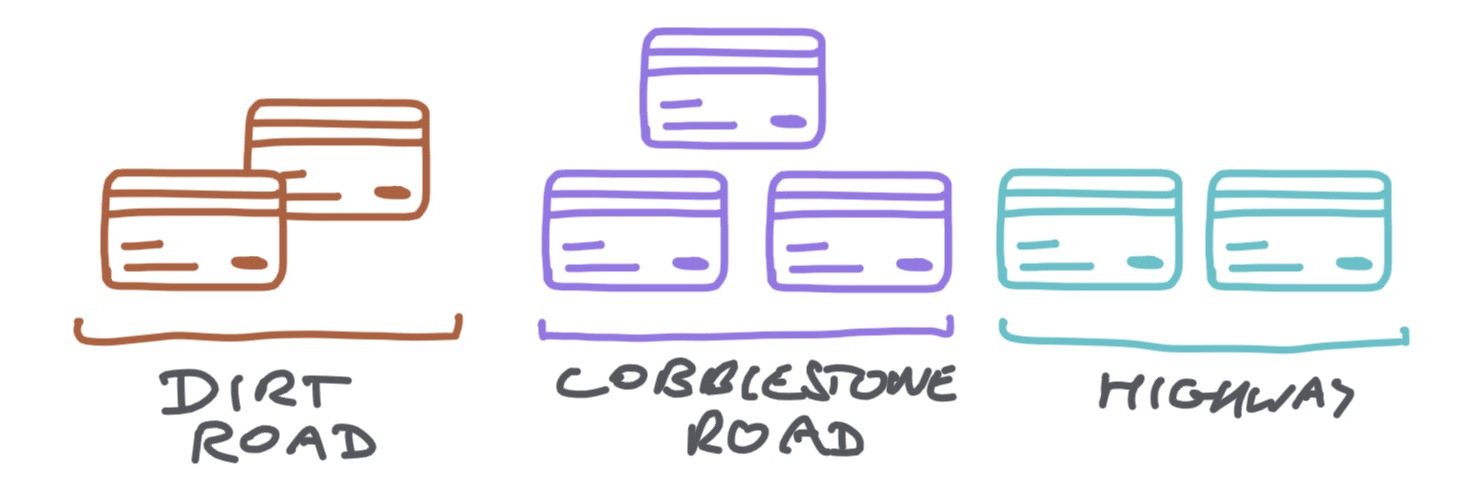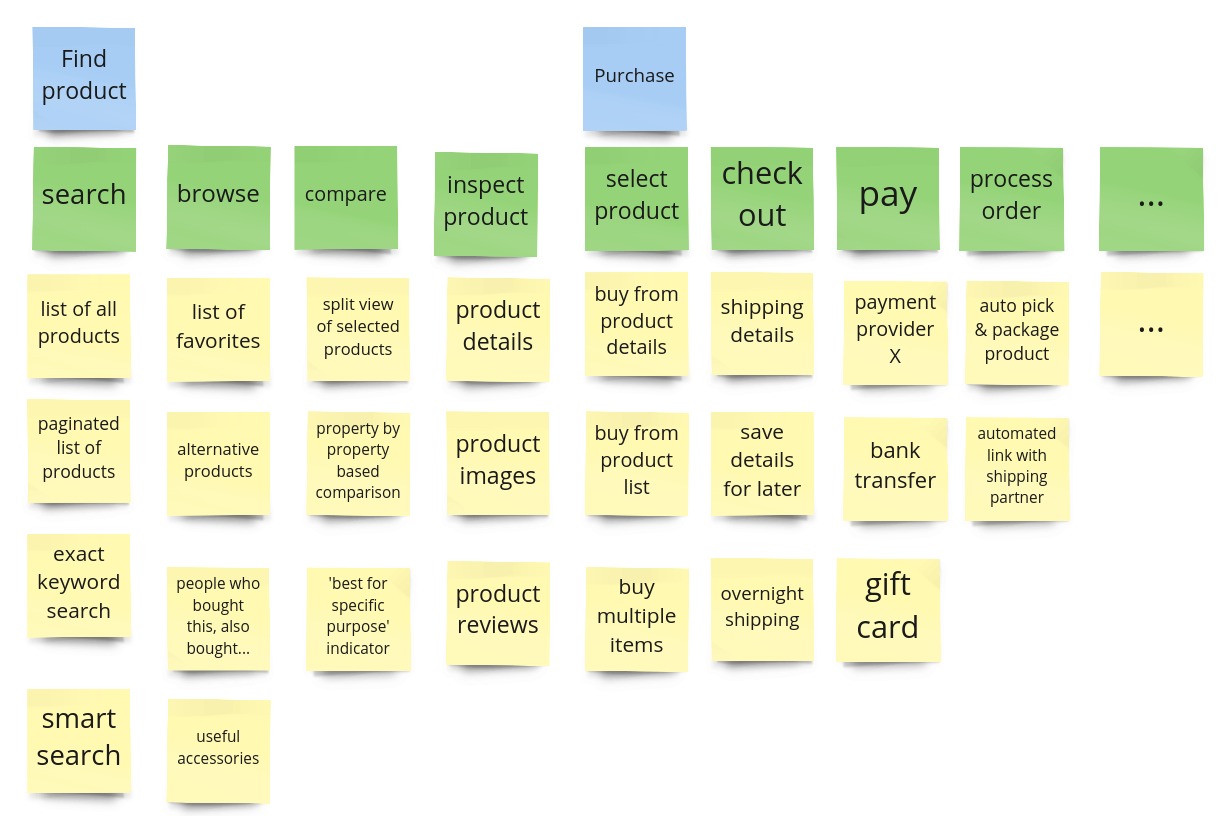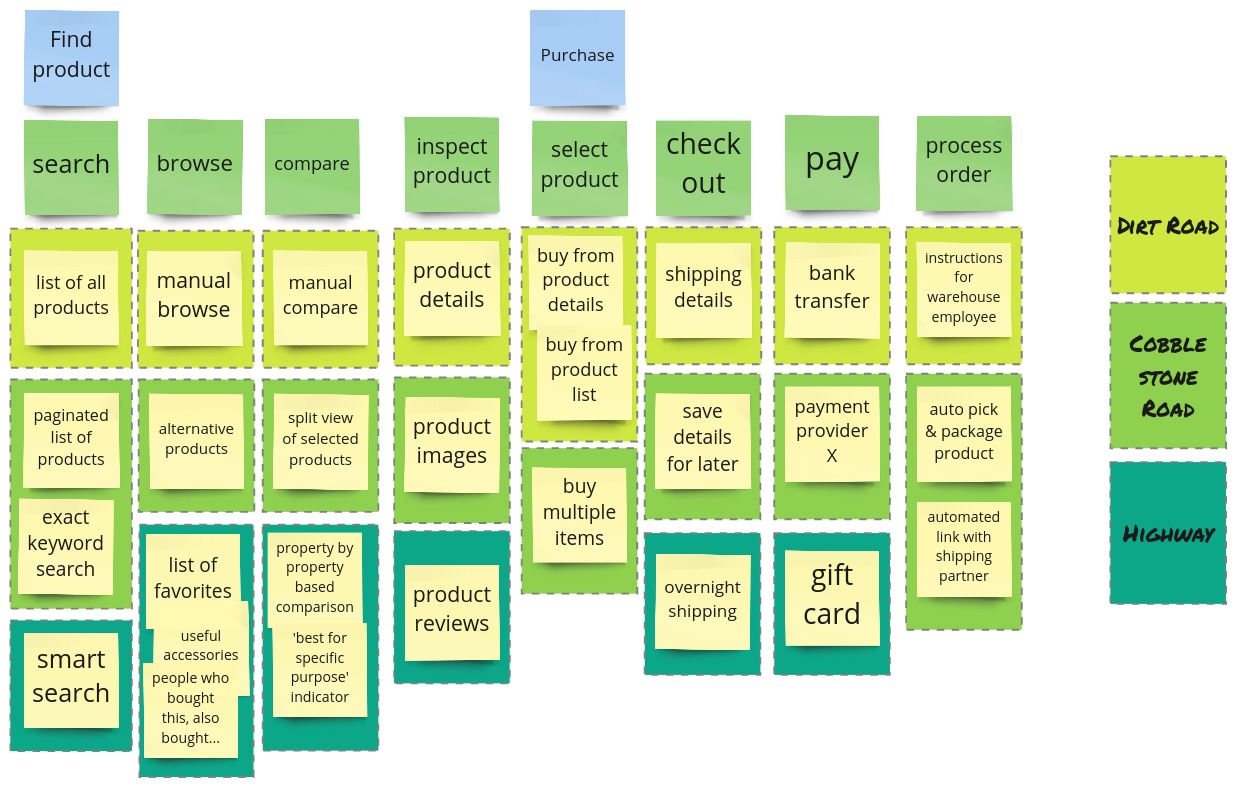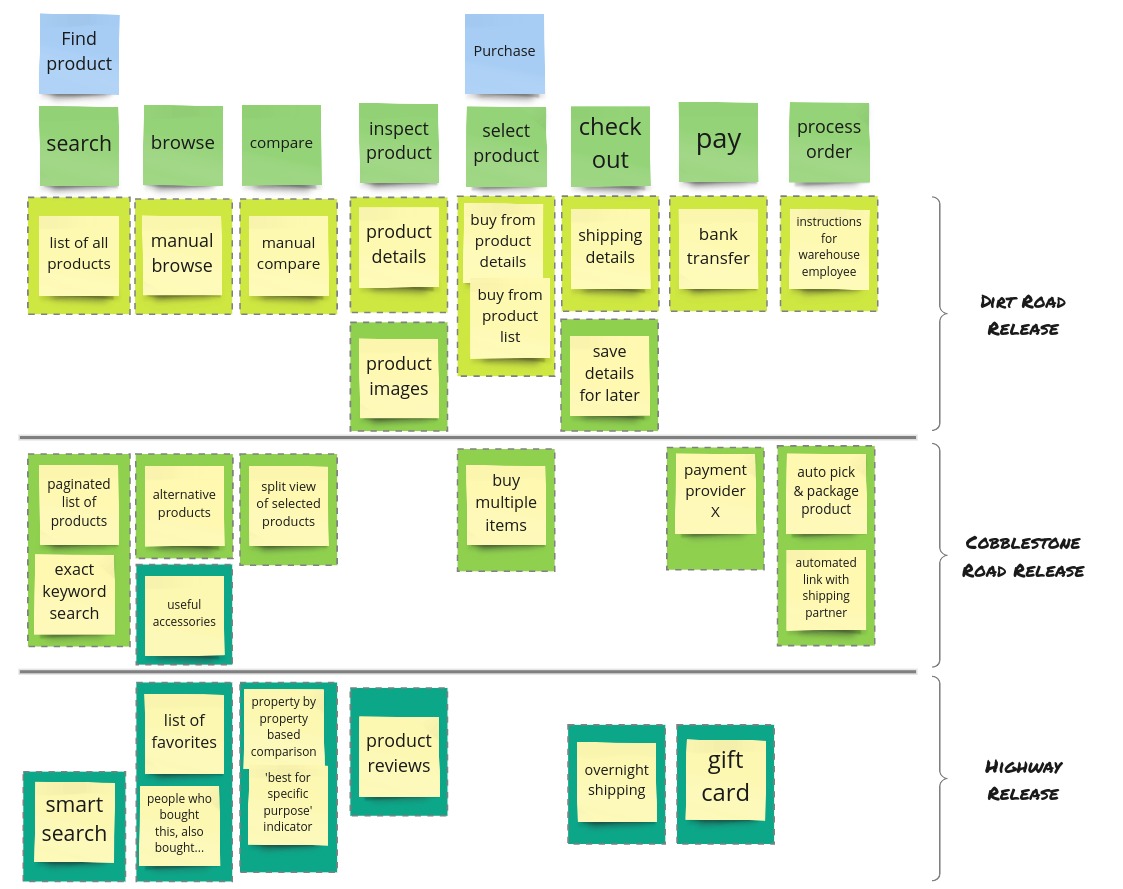In a previous post, we introduced the Dimensional Planning technique, and shared how we used this for a product we worked on. In this post, we will go more in depth and show how you can use the roads metaphor not only for releases of a product, but for individual features as well. This provides a fine-grained mechanism for planning and delivering small, valuable increments.
- Product level dimensions
- Feature level dimensions
- Fine grained planning & steering
- Summary
- References
Product level dimensions
We can apply dimensional planning for a software product at two levels: product level and feature level. In the previous posts, we focused mainly on product level dimensions - the Dirt Road / Cobblestone Road / Highway versions of a product.
The Dirt Road version is a minimal set of functionality, where the guiding question is what can we leave out? A Dirt Road web shop could have a product catalogue and a shopping basket, while we keep supply management, payment and order processing as manual processes. The Cobblestone Road version does the job, but not more than that. The guiding questions is is it good enough? The Highway version is a full blown implementation, where the guiding question is what do we still want to pay for?

Feature level dimensions
We can also look at a single feature and define Dirt Road, Cobblestone Road & Highway dimensions for that feature. Let’s look at features of a web shop. The dimensions of the Search feature could be:
- Dirt Road - just show list of all products and let the user use the browser search functionality;
- Cobblestone Road - offer keyword search with exact matching;
- Highway - provide smart search using word similarity and a list of synonyms.
We can define dimensions for instance based on quality requirements: the Dirt Road for the Product Catalogue could be a limited catalogue of say 30 products, which is shown fully. The Cobblestone Road version supports way more products with pagination and possibly lazy loading.
Having defined dimensions of features, you can base your product releases on this, as illustrated below.

You could call the dimensions of a feature or user story alternate depths of this feature. We elaborate the feature in several iterations, going from a shallow implementation or manual workaround to a full blown version with all bells and whistles. So feature dimensions embody true iterative working. This means that a feature or user story can repeatedly show up in the backlog, for different dimensions.
There are no hard rules for what a Dirt Road version and what a Cobblestone Road version of a feature is. Feature dimensions result from negotiation of the development team and their business or customer, guided by what can we leave out and what is good enough to achieve intended outcomes.
An example of feature dimensions
Having feature level dimensions provides a more fine-grained way of planning and negotiation. It provides more options to scale down a planned feature, e.g. from Highway to Cobblestone or Dirt Road when we want to deliver something valuable sooner.
The picture below shows part of a user story map for a web shop, with features like Search, Browse, Compare, Check out, and Pay.

We can define dimensions for the features. The Search Dirt Road is a simple list of products, while the Compare Dirt Road is a manual workaround: buyers can compare product details themselves, for instance by opening two products in separate browser tabs. The Pay Dirt Road is payment by bank transfer: the web shop shows just bank account details, the rest is manually processed. Integrating with a payment provider is Cobblestone Road, gift cards are the Highway for now.
For Inspect Product, the minimal version is showing the details, because otherwise buyers do not have sufficient information to decide to buy. The Cobblestone Road includes images.
Dirt Road Order Processing is mostly manual: the system shows information for the warehouse employee who will search & package the products. We first want to test the market before investing in order processing automation.

Having different dimensions of the Pay feature enables team negotiation about how well do we want to do the Pay feature, what is good enough and what more are we willing to invest in.
Fine grained planning & steering
Based on the dimensions of features, we can decide on Dirt Road and Cobblestone Road releases for the web shop. We decide to include product images and save details for later for now in the Dirt Road release, although they are probably the first thing to be moved out when we need to reduce scope for the first release.

After we have delivered the Dirt Road release, we can again look at the rest of the story map, asking ourselves what we can leave out and when is it good enough.
Summary
We can apply the Dirt Road - Cobblestone Road - Highway metaphor of Dimensional Planning not only to whole releases, but also to individual features. We can define Dirt Road, Cobblestone Road, and Highway versions of a feature, for instance based on different quality requirements.
This facilitates iterative development of features and user stories. A user story can occur multiple times in the backlog, in different versions. By defining the Dirt Road story and starting with that, this reduces the risk of story perfectionism and analysis paralysis.
Feature dimensions also facilitate finer grained planning, tracking and steering. Instead of all-or-nothing decisions for reducing scope - should we remove or include this story? - we can decide to keep a story but reduce its depth.
User story dimensions provide an extra way of splitting large user stories, in a true iterative way. In this way, dimensions enable the Negotiable property of Bill Wake’s INVEST heuristic for good user stories.
References
The idea of applying dimensions to both releases and features originates from Koen Van Exem, the inventor of Dimensional Planning. He calls them Alternate Futures and Alternate Depths. See also Koen’s original slides
To learn more about User Story Mapping, we recommend going back to the source - Jeff Patton’s original article or his book User Story Mapping.
This post is part of a series on Dimensional Planning:
- Dimensional Planning - good enough software, early & often
- Dimensional Planning - a story
- Dimensions of Dimensional Planning
- Dimensions of Features - an example
